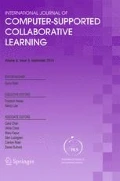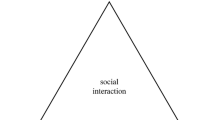Abstract
The advent of social networking tools allows teachers to create online networks and share information. While some virtual networks have a formal structure and defined boundaries, many do not. These unstructured virtual networks are difficult to study because they lack defined boundaries and a formal structure governing leadership roles and the transfer of information. The purpose of the study was to explore the relationship between how a member participates in a virtual blog network and the role of that member in the network. Unlike previous studies that use behavioral or structural characteristics of an individual’s network to infer social roles, this study utilized cluster analysis to combine behavior and structural information in role detection. Quantitative methods from social network analysis were used to compare the network structure of individual bloggers both across and within groups. The results indicate that how an individual participates in the network has an influence not only on their current role in the network, but also in how and how quickly their role in the community changes.





Similar content being viewed by others
References
Ali-Hasan, N. & Adamic, L. (2007). Expressing social relationships on the blog through links and comments. Paper presented at the International Conference for Weblogs and Social Media, Boulder, CO.
Amin, A., & Roberts, J. (2008). Knowing in action: Beyond communities of practice. Research Policy, 37(2), 353–369.
Anjewierden, A., Hoog, R., Brussee, R., Efimova, L. (2005, July). Detecting knowledge flows in weblogs. Paper presented at the 13th International Conference on Conceptual Structures. Kassel, Germany.
Baker-Doyle, K., & Yoon, S. (2011). In search of practitioner-based social capital: A social network analysis tool for understanding and facilitating teacher collaboration in a US-based STEM professional development program. Professional Development in Education, 37(1), 75–93.
Barab, S., & Duffy, T. (2000). From practice fields to communities of practice. Theoretical Foundations of Learning Environments, 1, 25–55.
Beaudoin, M. (2002). Learning or lurking? Tracking the “invisible” online student. The Internet and Higher Education, 5, 147–155.
Butlers, J. & Rijke, M. (2007, March). Discovering weblog communities: A content- and topology-based approach. Paper presented at the 1st Annual Meeting of the North American Chapter of the Association for Computational Linguistics, Boulder, CO.
Chen, F. (2004). Passive forum behaviors (lurking): A community perspective. In Y. Kafai, W. Sandoval, & N. Enyedy (Eds.), Proceedings of the 6th International Conference on Learning Sciences (pp. 128–135). Mahwah: Lawrence Erlbaum Associates.
Chin, A., & Chignell, M. (2006). A social hypertext model for finding community in blogs. In U. Wiil, P. Nurnberg, & J. Rubart (Eds.), Proceedings of the Seventeenth Conference on Hypertext and Hypermedia (pp. 11–22). New York: ACM.
Cho, H., Gay, G., Davidson, B., & Ingraffea, A. (2007). Social networks, communication styles, and learning performance in a CSCL community. Computers & Education, 49(2), 309–329.
Coburn, C., & Russell, J. (2008). District policy and teachers’ social networks. Educational Evaluation and Policy Analysis, 30(3), 203–235.
Cross, R., & Prusak, L. (2002). The people who make organizations go—or stop. Harvard Business Review, 80(6), 104–114.
Daly, A., & Finnigan, K. (2010). A bridge between worlds: Understanding network structure to understand change strategy. Journal of Educational Change, 11, 111–138.
Dang, T. & Viennet, E. (2012, January). Community detection based on structural and attribute similarities. In ICDS 2012, The Sixth International Conference on Digital Society (pp. 7–12).
de Laat, M., Lally, V., Lipponen, L., & Simons, R.-J. (2007). Investigating patterns of interaction in networked learning and computer-supported collaborative learning: A role for social network analysis. International Journal of Computer-Supported Collaborative Learning, 2, 87–103.
Dennen, V. (2008). Pedagogical lurking: Student engagement in non-posting discussion behavior. Computers in Human Behavior, 24(4), 1624–1633.
Efimova, L. & Hendrick, S. (2005). In search for a virtual settlement: An exploration of weblog community boundaries. Available at: https://doc.novay.nl/dsweb/Get/Document-46041.
Fraley, C., Raftery, A., & Scrucca, L. (2013). Mclust Package (Version 4.2) [Software]. Available from http://www.stat.washington.edu/mclust/
Fulton, K., Yoon, L., & Lee, C. (2005). Induction into learning communities. Washington D.C: National Commission on Teaching and America’s Future. Retrieved from http://citeseerx.ist.psu.edu/viewdoc/download?doi=10.1.1.174.959&rep=rep1&type=pdf.
Gee, J. P. (2005). Semiotic social spaces and affinity spaces. Beyond communities of practice language power and social context (pp. 214–232).
Gleave, E., Welser, H., Lento, T., & Smith, M. (2009). A conceptual and operational definition of ‘social role’ in online community. Paper presented at the 42nd Hawaii International Conference on System Sciences, Manoa, Hawaii.
Gray, B. (2004). Informal learning in an online community of practice. Journal of Distance Education, 19(1), 20–35.
Hanneman, R. & Riddle, M. (2005). Introduction to social networks. Retrieved from http://faculty.ucr.edu/~hanneman/nettext/
Hansman, C. & Wilson, A. (2002). Situating cognition: Knowledge and power in context. Paper presented at the annual meeting of the Adult Education Research Conference, Raleigh, NC.
Helms, H., Proulx, C., Klute, M., McHale, S., & Crouter, A. (2006). Spouses’ gender-typed attributes and their links with marital quality: A pattern analytic approach. Journal of Social and Personal Relationships, 23(6), 843–864.
Hough, B. (2004). Using computer-mediated communication to create virtual communities of practice for intern teachers. Journal of Technology and Teacher Education, 12(3), 361–386.
Instone, L. (2005). Conversations beyond the classroom: Blogging in a professional development course. Proceedings of ASCILITE Conference, Brisbane, Australia.
Johnson, D., & Johnson, R. (1999). Learning together and alone: Cooperative, competitive, and individualistic learning (5th ed.). Boston: Allyn & Bacon.
Judson, E., & Lawson, A. (2007). What is the role of constructivist teachers within faculty communication networks? Journal of Research in Science Teaching, 44(3), 490–505.
Kardos, S., & Johnson, S. (2010). New teachers’ experiences of mentoring; the good, the bad, and the inequity. Journal of Educational Change, 11, 23–44.
Killeavy, M., & Moloney, A. (2010). Reflection in a social space: Can blogging support reflective practice for beginning teachers? Teaching and Teacher Education, 26, 1070–1076.
Kozinets, R. (2010). Netnography: Doing ethnographic research online. Thousand Oaks: SAGE Publications Inc.
Lave, J., & Wenger, E. (1991). Situated learning: Legitimate peripheral participation. Cambridge: Cambridge University Press.
Leshed, G. (2005, July). Posters, lurkers, and in between: A multidimensional model of online community participation patterns. Poster presented at HCI International, Las Vegas, NV.
Lethinen, E., Hakkarainen, K., Lipponen, L., Rahikainen, M., & Muukkonen, H. (1999). Computer supported collaborative learning: A review. CL-Net Project. Available: http://www.kas.utu.fi/clnet/clnetreport.html
Lin, Y-R., Sundaram, H., Chi, Y., Tatemura, J., & Tseng, B. (2007). Blog community discovery and evolution based on mutual awareness. Proceedings of the IEEE/WIC/ACM International Conference on Web Intelligence (pp. 48–56). Washington, DC.
Little, J. W. (1990). The persistence of privacy: Autonomy and initiative in teachers’ professional practice. Teachers College Record, 91, 509–536.
Little, J. (2002). Locating learning in teachers’ communities of practice: Opening up problems of analysis in records of everyday work. Teaching and Teacher Education, 18, 917–946.
Lock, J. (2006). A new image: Online communities to facilitate teacher professional development. Journal of Technology and Teacher Education, 14(4), 663–678.
Luehmann, A., & Tinelli, L. (2008). Teacher professional identity development with social networking technologies: Learning reform through blogging. Educational Media International, 45(4), 323–333.
Marcos, J., Martinez, A., Dimitriadis, Y., & Anguita, R. (2006). Interaction analysis for the detection and support of participatory roles in CSCL. In Y. Dimitriades, I. Zigurs, & E. Gomez-Sanches (Eds.), Proceedings of the 12th International CRIWIG workshop: Groupware: Design, implementation and use (pp. 155–162). Berlin: Springer.
Mislove, A., Marcon, M., Gummadi, K., Druschel, P. & Bhattacharjee, B. (2007, October). Measurement and analysis of online social networks. Proceedings of the 7th ACM SIGCOMM conference on Internet Measurement (pp. 29–42). ACM.
Moen, P., Erickson, M., & Dempster-McClain, D. (2000). Social role identities among older adults in a continuing care retirement community. Research on Aging, 22(5), 559–579.
Mooi, E., & Sarstedt, M. (2011). A concise guide to market research: The process, data, and methods using IBM SPSS Statistics. New York: Springer.
Moolenaar, N., Sleegers, P., Karsten, S., & Daly, A. (2012). The social fabric of elementary schools: A network typology of social interaction among teachers. Educational Studies, 38(4), 355–371.
Nakajima, S., Tatemura, J., Hino, Y., Hara, Y., & Tanaka, K. (2005, May). Discovering important bloggers based on analyzing blog threads. Annual Workshop on the Weblogging Ecosystem, 2005. Chiba, Japan.
Pikas, C. (2008, December). Detecting community in science blogs. Paper presented at Fourth IEEE International Conference on eScience, Indianapolis, Indiana.
Ray, B., & Hocutt, M. (2006). Teacher-created, teacher-centered weblogs: Perceptions and practices. Journal of Computing in Teacher Education, 23(1), 11–18.
Schmidt, J. (2007). Blogging practices: An analytical framework. Journal of Computer-Mediated Communication, 12, 1409–1427.
Sclager, M., Fusco, J., & Schank, P. (2002). Evolution of an on-line education community of practice. In K. Renninger & W. Shumar (Eds.), Building virtual communities: Learning and change in cyberspace (pp. 129–158). New York: Cambridge University Press.
Scott, J. (2009). Social network analysis: A handbook. London: Sage.
Sing, C., & Khine, M. (2006). An analysis of interaction and participation patterns in online community. Educational Technology and Society, 9(1), 250–261.
Strijbos, J.-W., & De Laat, M. (2010). Developing the role concept for computer-supported collaborative learning: An explorative synthesis. Computers in Human Behavior, 26, 495–505.
Welser, H., Gleave, E., Fisher, D., & Smith, M. (2007). Visualizing the signatures of social roles in online discussion groups. Journal of Social Structure, 8(2), 1–32.
Wenger, E. (1998). Communities of practice: Learning, meaning, and identity. New York: Cambridge University Press.
Yang, S.-H. (2009). Using blogs to enhance critical reflection and community of practice. Educational Technology & Society, 12(2), 11–21.
Author information
Authors and Affiliations
Corresponding author
Rights and permissions
About this article
Cite this article
Smith Risser, H., Bottoms, S. “Newbies” and “Celebrities”: Detecting social roles in an online network of teachers via participation patterns. Intern. J. Comput.-Support. Collab. Learn. 9, 433–450 (2014). https://doi.org/10.1007/s11412-014-9197-4
Received:
Accepted:
Published:
Issue Date:
DOI: https://doi.org/10.1007/s11412-014-9197-4




